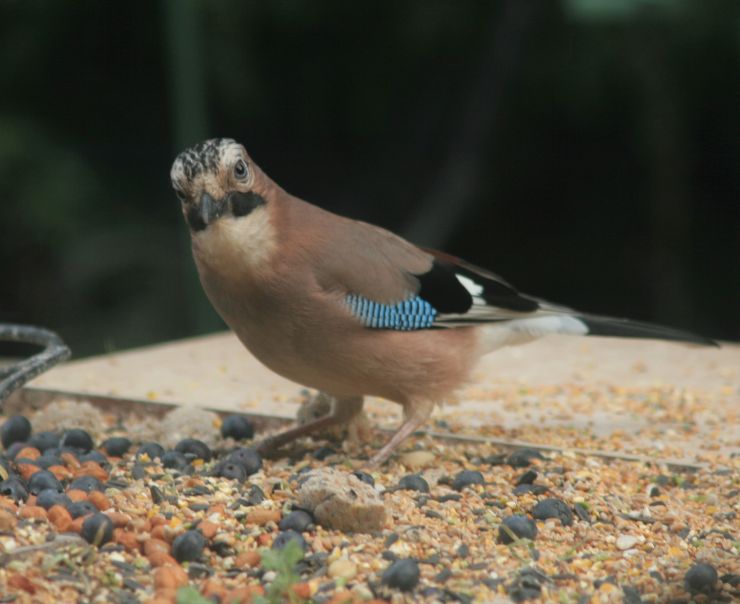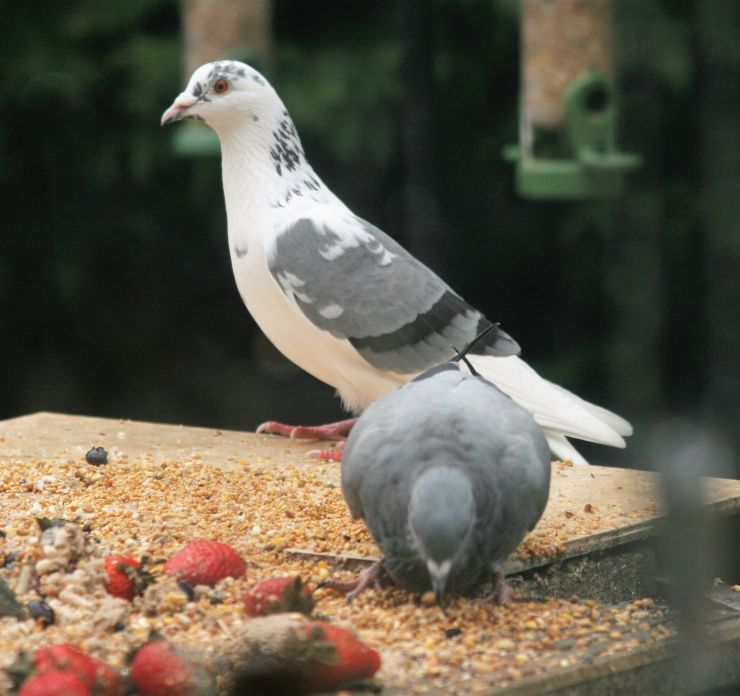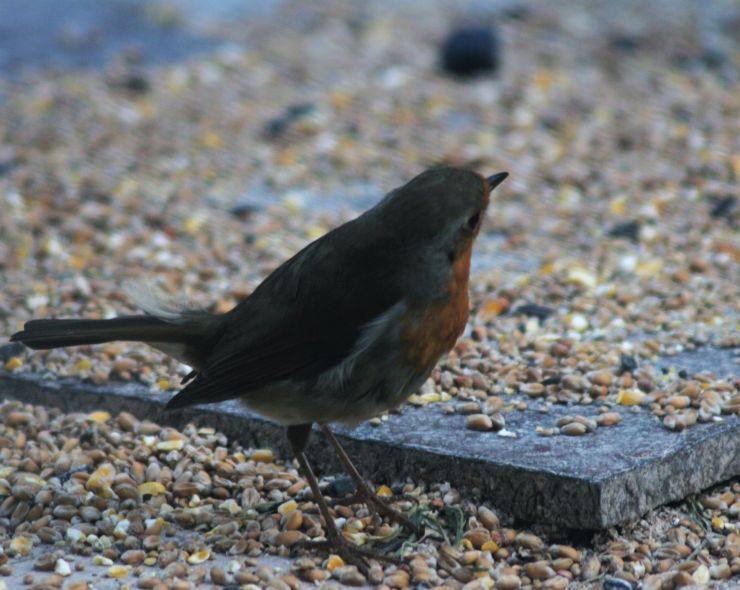- Home
- Cooking
- Roasting
- Frying
- Stir Frying
- Braising
- Steaming
- Baking
- Marinating
- Grilling
- Candy Making
- Deep-Frying
- En Papillote
- Curing
- Glaze
- Skewers and Kebabs
- Infusion
- Juicing
- Gravies and Sauces
- Making Pasta
- Outdoor Cooking
- Poaching
- Reduction
- Sautéing
- Soups and Broths
- Preserving Methods
- Fondue Methods
- Pané Methods
- Making Stocks
- Making Bread
- Griddling Methods
- Savoury Bakes
- Stews
- Making Salads
- About Cooking Crashes
- My Man's Cooking
- Patés and Terrines
- Roasting Meat
- Gardening
- Recipes
- Cakes and Bakes
- Fish
- Desserts
- Soups
- Stir Fry
- Meat
- Starters
- Snacks
- Smoothies
- Brunch
- Savoury Pies
- Vegetarian
- Salads
- Pasta
- Rice Dishes
- Picnic
- Stews
- Jams and Chutneys
- Burgers and Meatballs, Vegballs and Fishballs.
- Festive Recipes
- Sides
- Breakfast
- Pizza and Tartiflette
- Lunch
- BBQ and Grill
- Savoury Bakes and Gratins.
- Fondues
- Raclettes
- Leftover Recipes
- Sauces, Vinaigrettes, Dressings and Dips
- My Recipes
- Seasonal
- Tips
- Ingredients
- Cheese
- Fruits
- Vegetables
- Meat
- Fish
- Eggs
- Breads and Bakes
- Spices
- Herbs
- Sauces, Pastes and Stocks.
- Nuts
- Dairy
- Condiment
- Seaweeds
- Baking Ingredients
- Seeds
- Pastas and Noodles
- Pastries and Batters
- Shellfish and Seafood
- Oils, Vinegars and Cooking Fats
- Leaves
- Preserved Food
- Snacks
- Stuffing and Mincemeat
- Edible Succulents
- Edible Flowers
- Tofu
- The Unusual Delicacies.
- Honey
- Rice
- Sommelier
- Pets
- Wildlife
- News
- Reviews
- About
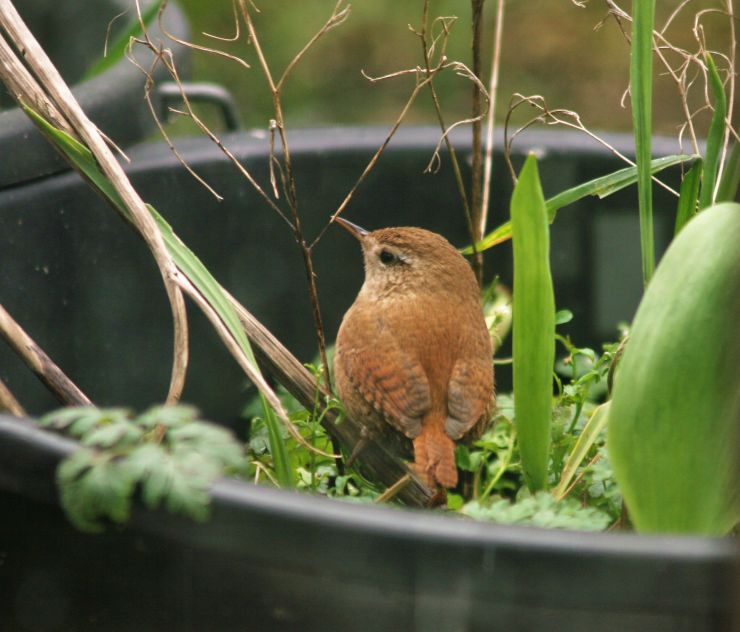
Our little Garden Wren.
Since we started feeding the Birds, we saw an increase over the years of our population of Birds in the Garden. Initially we fed them on a slate in front of our back garden window door. It was to teach our Cats to be indoor Cats but to stay happy Cats which had something to watch and to keep them entertained and occupied.
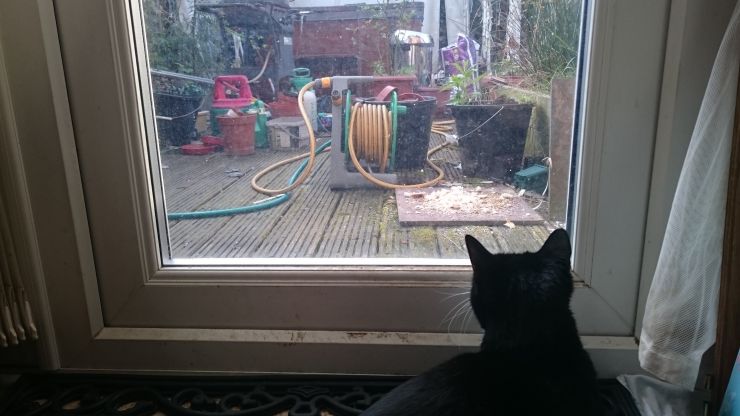
The start of Cat TV: Waiting for the Birds to come. (RIP Pepsidou watching)
The fact that our Cats were now indoors and with the combination of us giving food to the Birds, the Birds gradually came back. First we had a couple of Wood Pigeons then a trio of them.
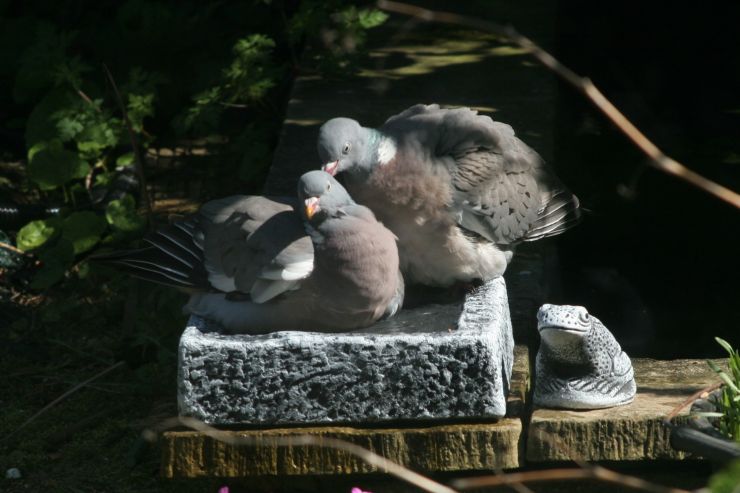
A couple of Wood Pigeons in the Bird Bath.
To be honest we were just novices at feeding Birds and Cat TV was just an idea/a concept which determination was if it works it works, if it doesn't, it doesn't. Starting with Breadcrumbs, we had the Wood Pigeons. The Cats were happy. So we decided to get some Grains. The result was that more Birds came forward to the slate. One of our resident Robin which we called Mr Plumpy investigated the slate and the Food on offer. That little Bird lived for six long years and came to my feeding whistling call. He left us his family for we have three Robins in the garden which are not competing with one another.
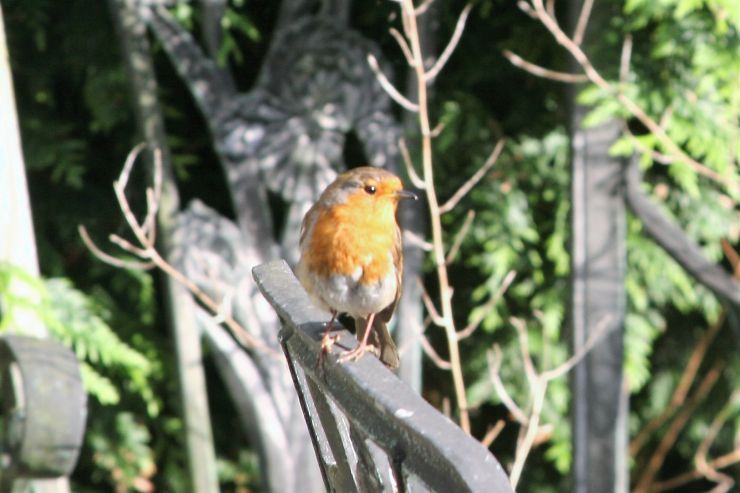
Mr Plumpy, the Robin.
To be sure when we saw the Robin we decided to get a small packet of Grains weekly with our shopping for the Birds. Then it was pretty much when we were working at our desks the interpelation to distraction: 'Look the Robin is here'. Call a Cat a Cat, we were engrossed by Cat TV just as much as a Cat... Then we had Black Birds, one, just the one.
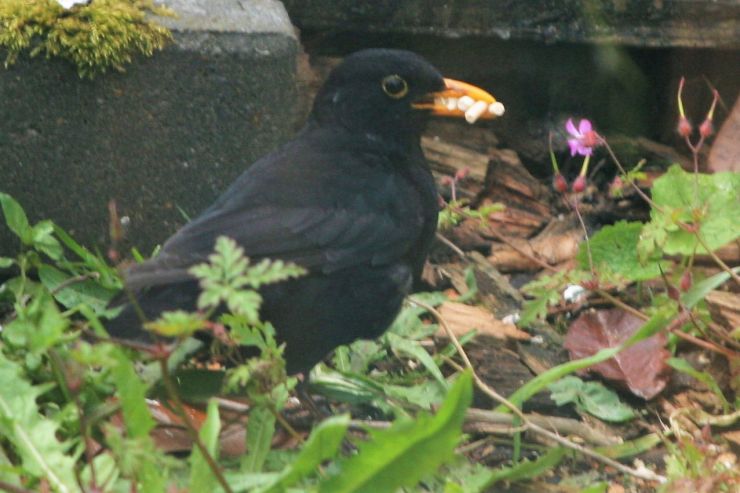
Blackbird feeding on Suet nibbles.
Now we do have two couples of Blackbirds in our trees. One day however we left the old office to the spanking new one and bigger one. So Cat TV moved along to another position in front of the double door windows facing the garden. We didn't know if the Birds would move along with their feeding station being elsewhere, closer to the other fence of the Garden. We shouldn't have worried with those speculations...
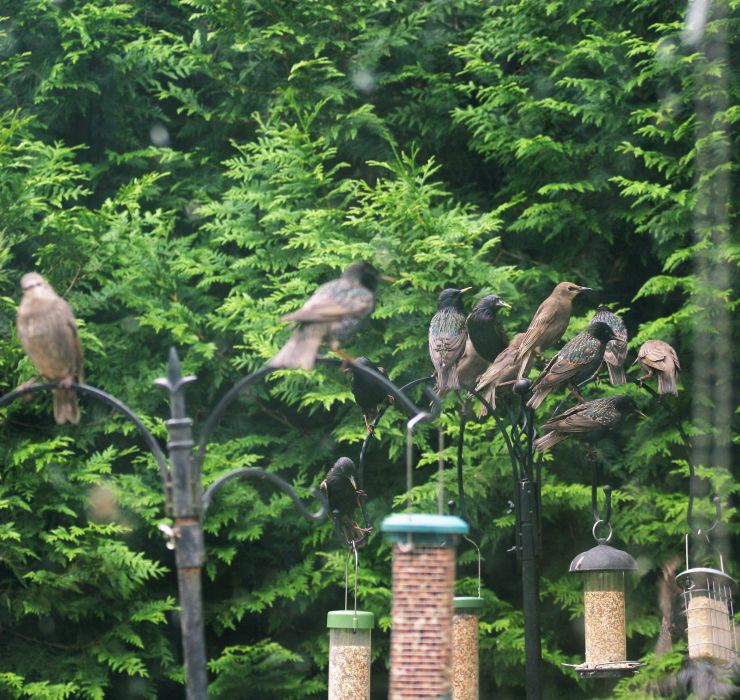
Our Mobsters: The Starlings.
One harsh Winter, the glass table top of our garden table broke/ split during a very frosty night. The base of the table being of a lovely shaped cast iron, there was no way we would discard it. We did a make shift table top of planks for the Birds to use on that cold Winter and ever since it did become the Birds' table. It is completely theirs since ages now. The amount of Food we do get for the Birds weekly did increase like their feeding station...
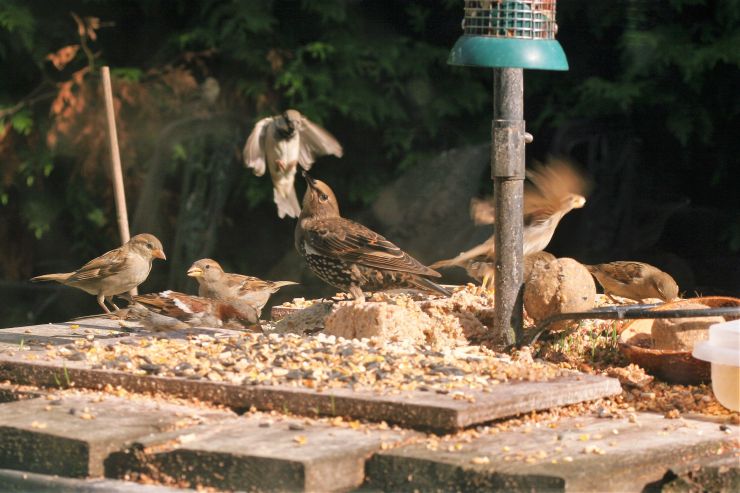
The Feeding Birds Station: totally improvised during one Winter when we wanted to help the Birds to survive the cold. It has become a feature in the Garden in a very DIY rustic way.
This table extension made us be proper Bird Watchers. I would say our curiosity increased as the time went by but also witnessing the effects of the Seasons upon our Birds. From the courtships and the hatching of the chicks in Spring, to the rearing of the youngs in early Summer to migrations either back or either forth, it is very engrossing. So much so that we do have our pocket guide about Birds. It also has to be mentioned that there are some trepidation when we see a new type of Birds in the Garden.
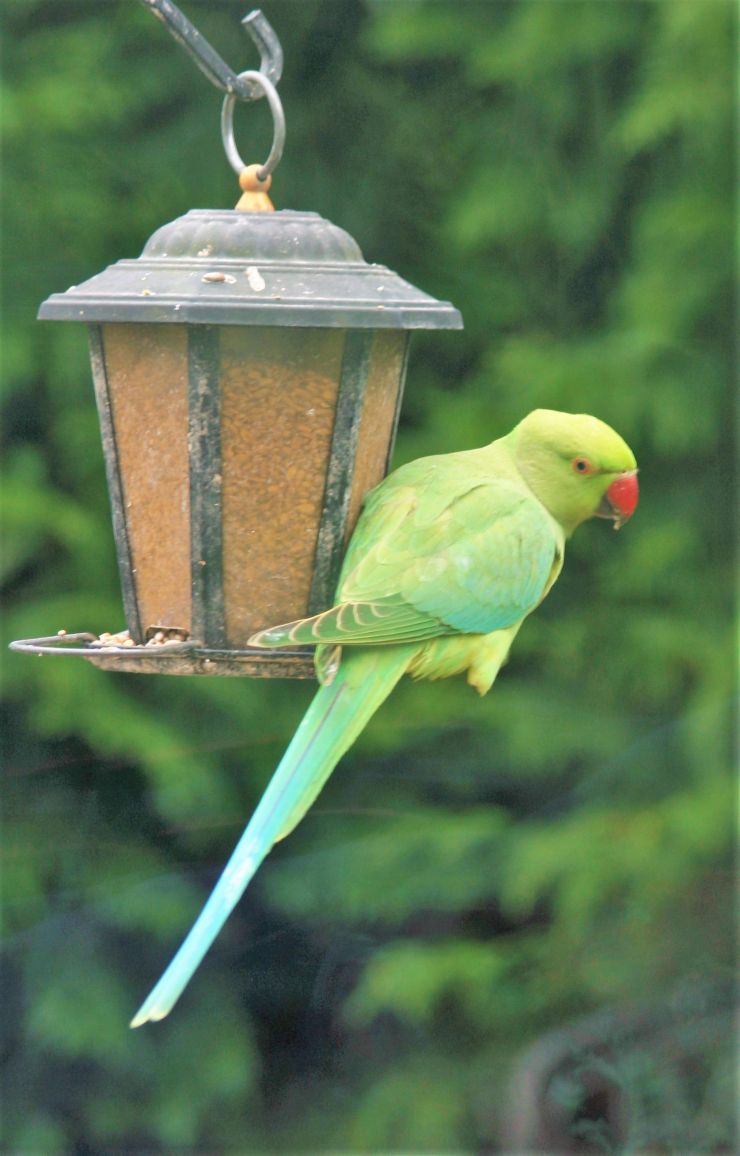
Our Parakeet. This was an intriguing character popping by our Garden but the legend has it that the Parakeet population in London is due to the African Queen movie which was done in the Elstree Studios back in the days. (The Studios are not far from my Home). They released the Parakeets used in the film to the wild and the Birds did well, survived the British weather and are rather thriving. You can see a flock of them in Bishop's Park in South West London.
From the slightly unusual we are going to a more common Bird, the Sparrow which has been in decline almost everywhere. The population decline of Sparrows could be due to many factors, pollution, pesticides, lack of food, cats and foxes, but also loss of habitat.
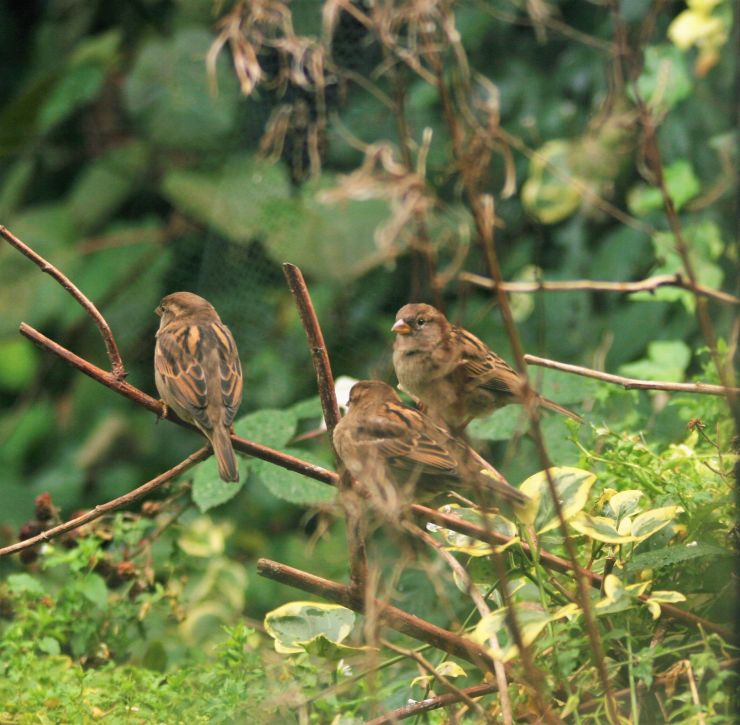
Three little Female Sparrows.
I will say this a decade ago there were not that many Sparrows in our Garden. We could probably have counted them on the fingers of one hand. I would tell that three important factors did help to have a healthy population of Sparrows. First as funny or sad as it is the Creation of Cat TV played its part. Because I didn't want to find a little Bird injured by a Cat, one of mines, in my Kitchen ever again.
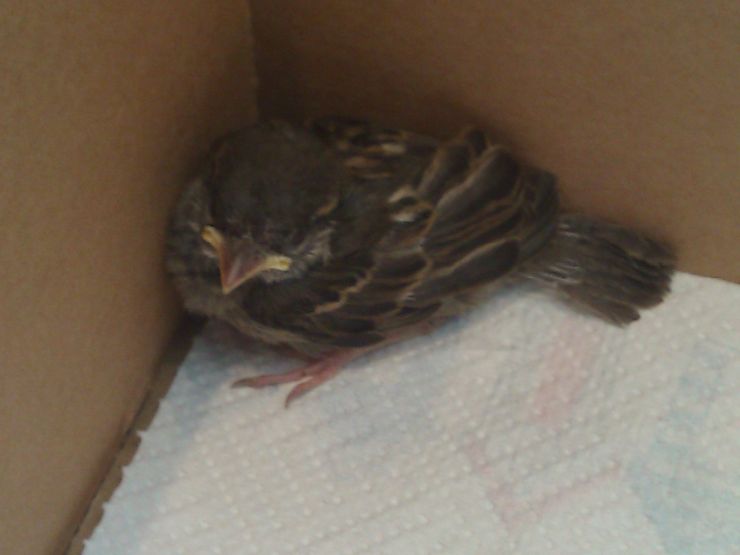
The little Sparrow passed away the very same day I found it in my Kitchen. It was ever so sad. I went on a shopping trip for the little Bird because I didn't know from which nest it was plucked out from by my Cat. I came back with a cage with all the gimmicks and all the appropriate Food. But she still didn't make it, and the RSPCA didn't have time to bother for a Sparrow.
Her cage went to a good home with a father and a mother who were buying a Canari Bird for the birthday of their little Girl. From one bad thing or event we must reach out for a positive or somewhat see a positive. It is hard to do unless you have the Pollyanna Syndrom inbuilt into you. When our Pepsidou ended up with a leg damaged by a car on one of her wandering about, it was so bad that it had to be the amputation or the loss of her life. We did choose for her to live and be our little tripod Cat. Then we kept all Cats indoors and created Cat TV. Then miracles did happen.
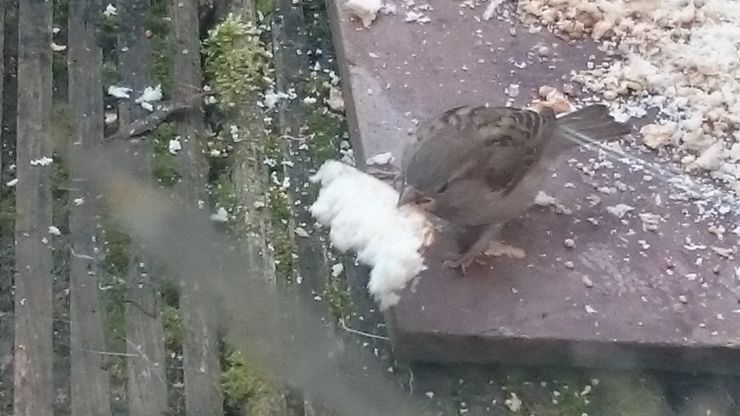
The First days of Cat TV... Cats are safe, Birds are safe. Everything started from there really for us. But it took two or lets say three tragic events to come up/ conjure up that idea.
Life is a learning curve. We didn't have a very big clue about how to feed the Birds outside at that time: Breadcrumbs, Bread in pieces and some Seeds. Like the picture above shows clearly with a little female Sparrow trying to munch through a piece of Bread. However our interest in the welfare of our Garden Birds grew to a level of knowledge on how our actions could benefit them best.
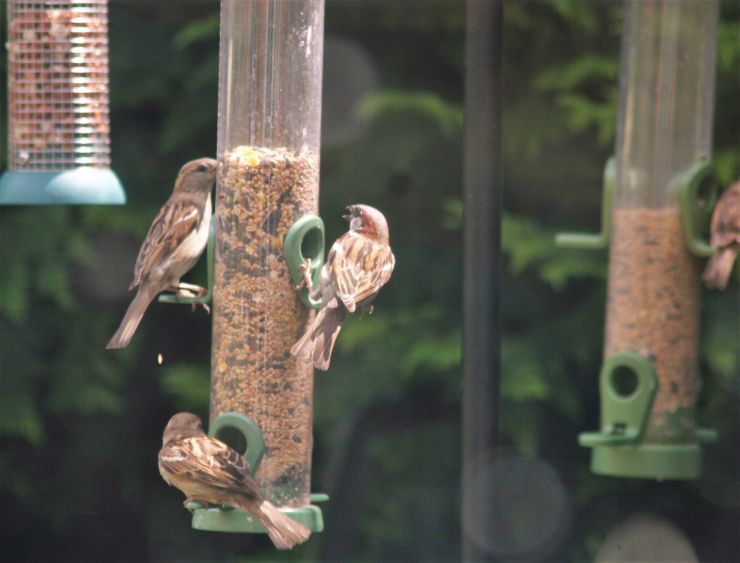
Sparrows feeding time nowadays in our Garden.
We were so keen to help that feeders were put in place very soon after the Bird's table was. Different Birds have of course different diets so to offer a wide range of Food was as per say essential. It did attract many birds. However our Sparrow population did increase a great deal of a lot and I will reveal that it is about food but it is also more than that...
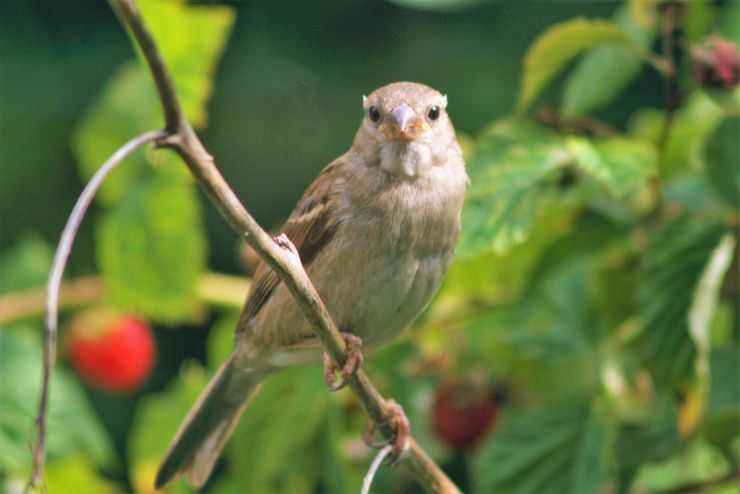
Baby Female Sparrow on our Raspberry Bush.
The fact is that we do love gardening. But when my health was declining I went to go the organic way in the Garden as well as in my shopping bag so I will know what I will properly eat. For about eight years now the Garden is free of pesticides. Instead I introduced back an ecosystem of its own. Slug issue: Frogs can deal with that, Green Fly issue: Ladybirds can deal with that, Clog Soil: Earth Worms can deal with that. The result is that everything from Slugs for the Birds and Frogs, to Raspberries for the Birds or ourselves that are edible without damaging our bodies. And for the Sparrows it was this, (Food for thought). The result is below:
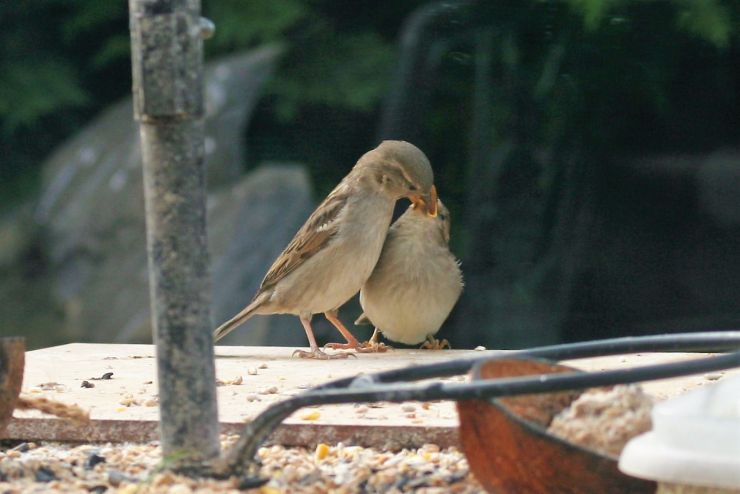
I will say that it doesn't take much, just consideration. There we have it, a nursery of Sparrows in our Garden.
To establish a healthy ecosystem is key then you will see the reward. The reward is bountiful, love the earth and the earth will love you back. I am not trying to sing to you 'Good Morning Starshine' from Hair, however to open up to the fresh air helps a great deal of a lot, us as humans, and nature when we care for it. When my neighbours went all crazy with a cutting their trees in their garden square, when my Partner wanted to follow the trend, I stepped in and said not in my Garden! For heaven's sake! I know we all want a pretty Garden but to what cost and what cost for the life out there: Lost of habitat. Who would like their roof to be removed from above their heads? The result is below, we ended up within our eleven tall pine trees with the Sparrows of our area.
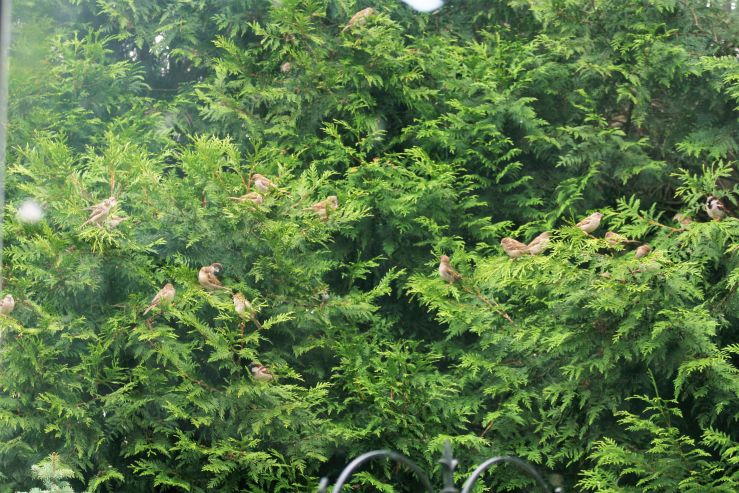
Counting the Sparrows time... If you succeed you are lucky. All in all keep the habitat for the birds alive and they will stay alive.
So I will say it again, if you like to watch a Bird make sure you keep its habitat alive. It can be hard because of storms and bad weather but it is like this for everyone human or animal: try to survive through it all. We did partialy lost a pine tree during a storm but we did put it upright again and this is what we do = we deal and move on, with care. The tree is alive and well now.
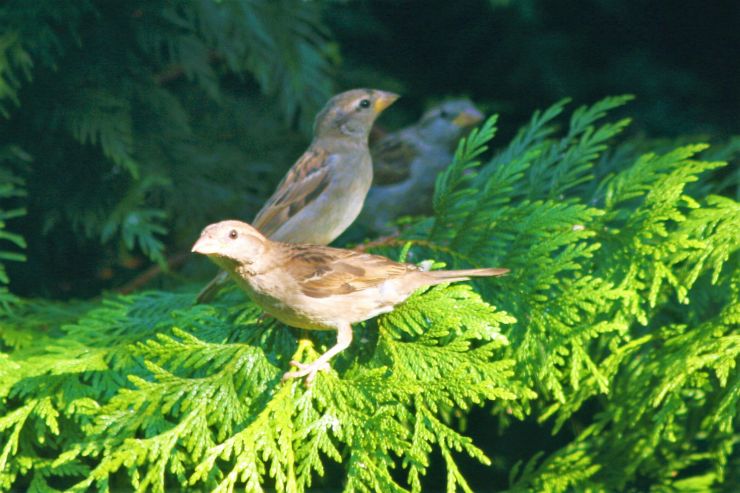
Three little female Sparrows in our Pine Trees.
There is something we did notice, from one very social bird to another, the Starling, it is that Starlings are supposed to migrate but they are not always doing so. We do have plenty of Starlings in our Garden. A fair few years ago now, they started nesting in our trees. There are usually two batches of baby Starlings, the early Spring ones and the late Spring ones. The early Sring ones used to migrate with their parents and the flock, the younger ones remained behind to fend for themselves in our Garden. So we did look after them. The Starlings always came back from their migration to nest every Spring but then a fair amount of them remained in our neck of the wood all year round, no more migration.
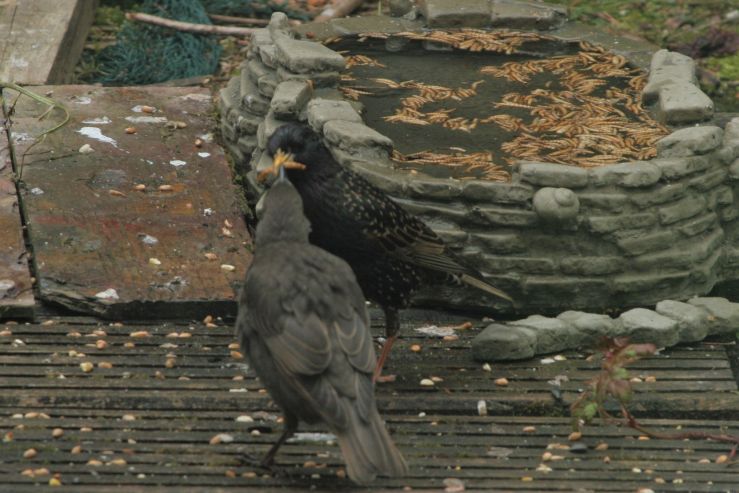
Starling feeding its young. We give them Mealworms as well as Grain, Seeds and Suet.
The Starlings live in rather large communities which are very interesting to watch. They are rather rowdy with one another but also protective of one another. Starling parents look after their youngs after they are fledged. They do not let them to fend for themselves straight away. The same applies to Sparrow who care after their chicks for a while after they left the nest.
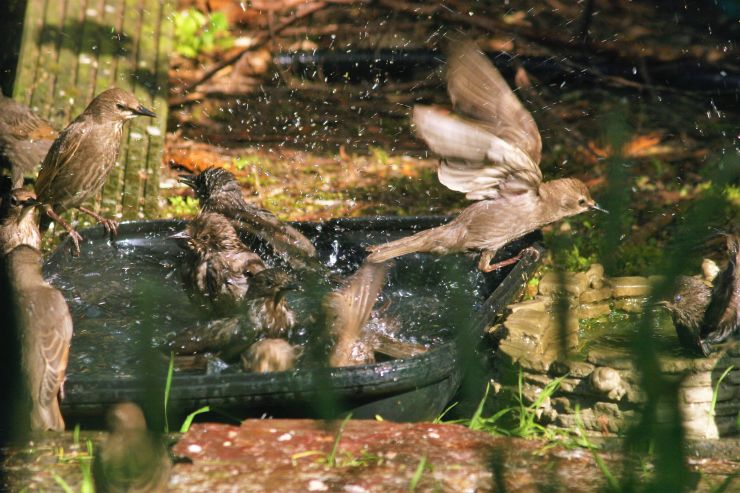
Our young Starlings and the emergency Bird Bath one very hot Summer. We only had one little square Bird bath at that time so we improvised and added the lid of a large recycling paper bin to give our 'Mobsters' some space to splash around and cool a little bit. This is what happened: Swimming pool time.
In a Garden where the ecosystem takes back control some rough tragedy can happen. We did loose a young Starling to a Sparrow Hawk one day, and two Starlings went inside our pond. We rescued them both but if one made it for the other it was too late. For another stalker we have a Heron which like having a pick for lunch on our Koi Carps once in a while. There is a river nearby so the Heron is more busy elsewhere. However the Sparrow Hawk decided to nest in our tall trees. There is a private airfield nearby where they keep Birds of prey in order to keep the Pigeons away. We think we do have one of their Birds who decided that our Garden was a perfect place to be.
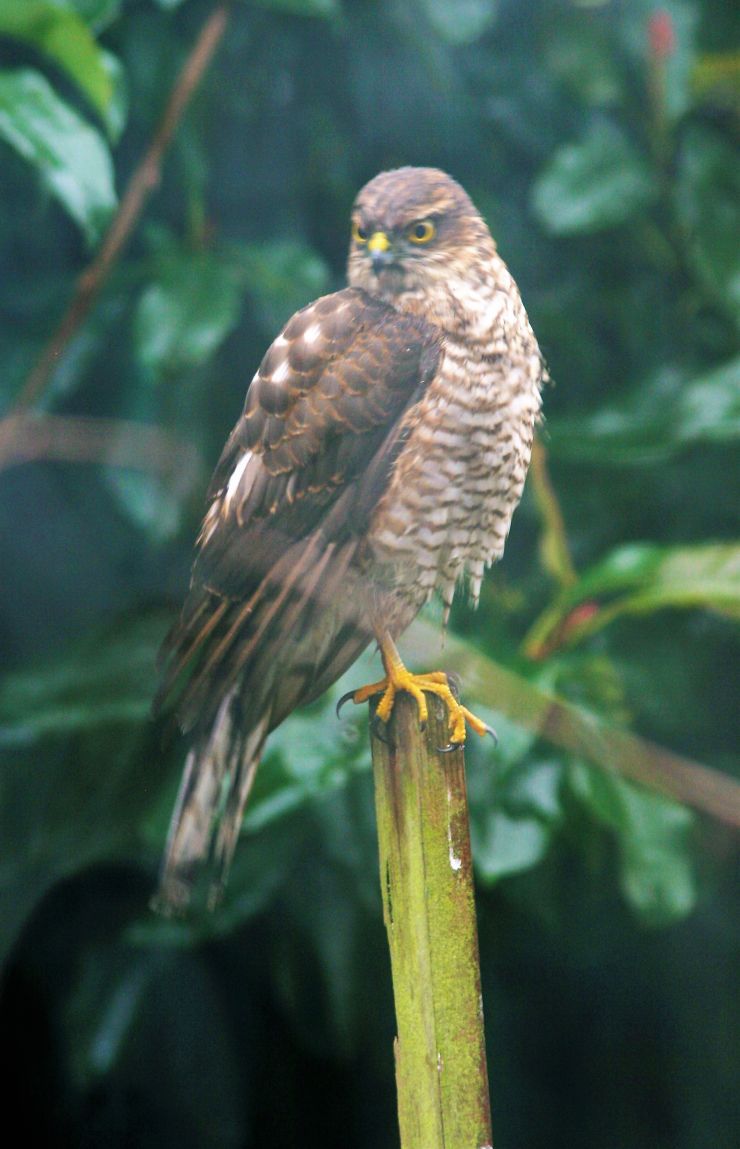
Our Sparrow Hawk 2021.
Speaking of Pigeons or what is classified as Rock Doves, we have a great deal of a lot. I whistle whenever I feed the Birds and the Rock Doves usually flock onto the top of the roof. They wait and when I am back inside, they land on the Feeding Table to have their Feast. We do have a white gene in our Rock Doves but it is not for all of them only for some of them, it renders them patchy. It started with a distinctive Rock Dove which I called 'My Friend'. Then we had still 'My Friend' and other Rock Doves with white amongst their feathers showing up.
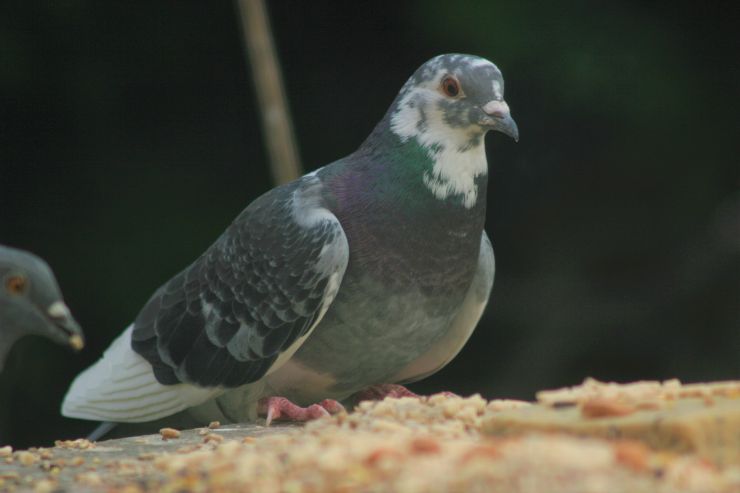
The Rock Dove called 'My Friend'. It has been a regular visitor of our Garden since 2017.
Darwin was a keen Pigeon fancier and I know why now. It is genetically interesting just like Mendel did his study with his Peas. But my Rock Doves will stay free and do what they like and want. However I would love to ring all the Birds in my Garden to follow them through on their flying journeys and to know that they are alright, what happened to them or their next generation.
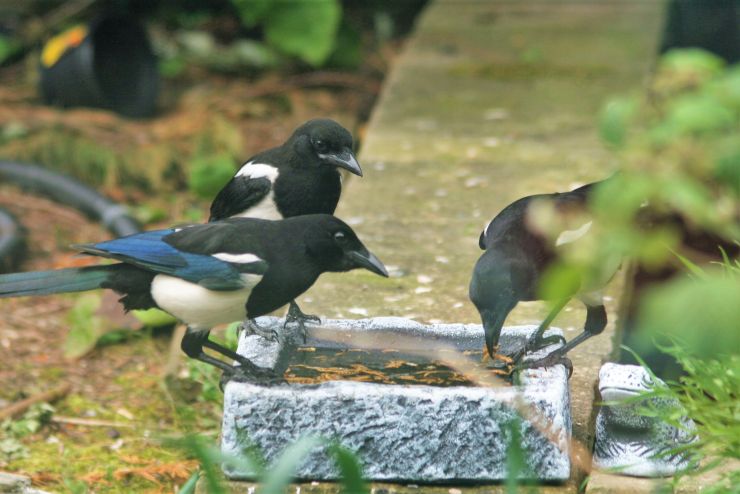
Our new generation of Magpies eating the wormies. Putting the Mealworms in the bird bath render them soft and easy to eat for young Birds.

